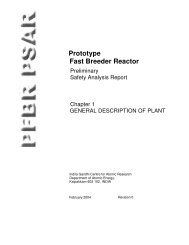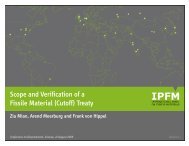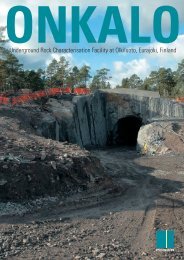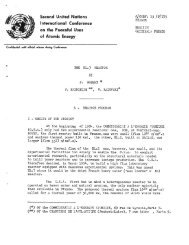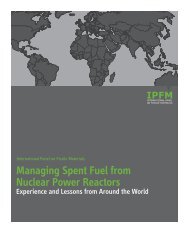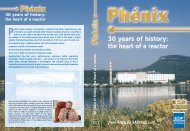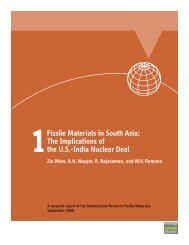Nuclear Proliferation TechnologyTrends Analysis - International ...
Nuclear Proliferation TechnologyTrends Analysis - International ...
Nuclear Proliferation TechnologyTrends Analysis - International ...
You also want an ePaper? Increase the reach of your titles
YUMPU automatically turns print PDFs into web optimized ePapers that Google loves.
PNNL -14480<br />
scale, using the centrifuge designs developed by the Navy. The commercial enrichment<br />
plant is based on a third generation super critical centrifuge with a carbon fiber rotor.<br />
Throughput is expected to be 5-10 swu/yr.<br />
It took the Brazilians eighteen months to construct the initial phase of the facility, and it<br />
began commercial operation in 2002. They plan to be able to produce 20,000 swu/yr in<br />
the initial phase, reaching full capacity in 2007.<br />
Brazil had three distinct centrifuge generations, each separated by about a ten-year<br />
development program. The generations went from sub-critical maraging steel rotors to<br />
sub-critical carbon fiber rotors to super-critical carbon fiber rotors. The throughput<br />
approximately doubled for each generation, going from 1-2 swu/yr to 3-5 swu/yr to 5-10<br />
swu/yr.<br />
3.2.3.5 India<br />
India began research into centrifuge enrichment in 1975 and, by 1985, had a 100-<br />
centrifuge cascade that operated successfully. India’s centrifuge design used a subcritical<br />
maraging steel rotor that had a likely throughput of less than 3 swu/yr. After two years of<br />
pilot plant operation, they began construction of a second facility and had it in operation<br />
by 1992. It consisted of several hundred operating centrifuges of domestically produced<br />
maraging steel. The purpose of this plant was to develop capability to enrich fuel for<br />
India’s reactors, as the French were ceasing to provide fuel for them 30 .<br />
Many of the Indian centrifuges machines prematurely crashed or otherwise proved<br />
defective. Due to technical limitations encountered, it was decided in 1997 to build and<br />
install rotor assembles of an improved design at its pilot centrifuge plant 31 .<br />
Indications are the Indian program had only one design over a 25 year period, which<br />
proved ineffective. The new designs were apparently not a new generation, but rather are<br />
improvements.<br />
3.2.3.6 Pakistan<br />
The Pakistani program (besides the Soviet Union the only successful program to date<br />
specifically intended to develop weapons grade HEU) did not use intrinsically-developed<br />
technology.<br />
Pakistan began a centrifuge enrichment program in 1973. In 1975 Pakistan acquired<br />
plans for early Urenco centrifuges, using both aluminum and maraging steel, and built<br />
cascades of both types 32 . As it had a limited technological capability, Pakistan<br />
purchased centrifuge-related equipment from companies in Germany, The Netherlands,<br />
the United States, France, and China. In this process, an international clandestine<br />
30 Second Indian Enrichment Facility Using Centrifuges is Operational, Mark Hibbs, Nucleonics Week, Vol. 33, No.13; Pg 9,<br />
3/26/1992<br />
31 India to equip centrifuge plant with improved rotor assemblies, Mark Hibbs, <strong>Nuclear</strong> Fuel, vol.22 No. 24; Pg 7, 12/1/1997<br />
32 Pakistan Builds Second Plant to Enrich Uranium, Simon Henderson, Financial Times (London), 12/11/1997<br />
24



